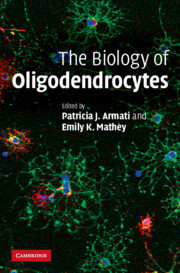Book contents
- Frontmatter
- Contents
- Preface
- Contributors
- 1 CNS oligarchs; the rise of the oligodendrocyte in a neuron-centric culture
- 2 Comparative biology of Schwann cells and oligodendrocytes
- 3 Control of oligodendrocyte development and myelination in the vertebrate CNS
- 4 Molecular organization of the oligodendrocyte and myelin
- 5 The genetics of oligodendrocytes
- 6 Immunobiology of the oligodendrocyte
- 7 Oligodendrocytes and disease: repair, remyelination and stem cells
- 8 Glial progenitor cells and the dynamics of the oligodendrocyte and its myelin in the aged and injured CNS
- 9 Oligodendroglial pathology in multiple sclerosis
- 10 Glutamate receptors, transporters and periventricular leukomalacia
- References
- Index
- Plate section
8 - Glial progenitor cells and the dynamics of the oligodendrocyte and its myelin in the aged and injured CNS
Published online by Cambridge University Press: 05 August 2012
- Frontmatter
- Contents
- Preface
- Contributors
- 1 CNS oligarchs; the rise of the oligodendrocyte in a neuron-centric culture
- 2 Comparative biology of Schwann cells and oligodendrocytes
- 3 Control of oligodendrocyte development and myelination in the vertebrate CNS
- 4 Molecular organization of the oligodendrocyte and myelin
- 5 The genetics of oligodendrocytes
- 6 Immunobiology of the oligodendrocyte
- 7 Oligodendrocytes and disease: repair, remyelination and stem cells
- 8 Glial progenitor cells and the dynamics of the oligodendrocyte and its myelin in the aged and injured CNS
- 9 Oligodendroglial pathology in multiple sclerosis
- 10 Glutamate receptors, transporters and periventricular leukomalacia
- References
- Index
- Plate section
Summary
INTRODUCTION
Louis-Antoine Ranvier first described myelin in 1878 (Ranvier, 1878); however it was not until 1928 that del Rio Hortega described the oligodendrocyte – the myelin-forming cell of the CNS (Hortega, 1928). Myelin pathology present in spinal cord injury was first mentioned in 1907 (Holmes, 1907) and had become more widely recognized by the 1960s (Bunge et al., 1960). Today the oligodendrocyte with its compact and non-compact myelin components has become an avidly pursued therapeutic target, yet our understanding of the physical and functional changes in the oligodendrocyte myelin with injury are relatively understudied and misunderstood.
Spinal cord injury (SCI) is a devastating condition currently affecting 250 000 people in the United States, with 11 000 new cases recorded each year (2005). SCI is a complex neurological disorder with varied pathological patterns. The majority of injuries result in permanent anatomical and functional deficits. The most frequent type of injury – contusion injuries in the cervical and thoracic regions – is caused by a bone or disk displacement into the spinal cord due to bone dislodgement or fracture of the spinal column (Rothman and Simeone, 1992). Few injuries are caused by laceration or transection of the spinal cord. Contusion injury is typified by a necrotic core or cavity, which is partly surrounded by a rim of remaining white matter containing spared descending and ascending axons (Balentine, 1978a; Blight, 1983). SCI results in a loss of function due to the disruption of sensory and motor pathways and glial cell support.
- Type
- Chapter
- Information
- The Biology of Oligodendrocytes , pp. 154 - 170Publisher: Cambridge University PressPrint publication year: 2010

